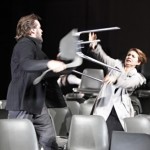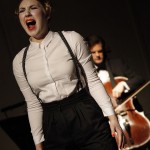By: Edna Landau
House concerts are a wonderful way to discover new talent. My friend Michael Reingold, who is the founder and Artistic Director of New York House Concerts, recently invited me to hear a young American cellist by the name of Dane Johansen in a concert consisting of two Bach solo suites and a solo suite by Gaspar Cassadó. I knew very little about Mr. Johansen upon arriving at the concert but quickly ascertained that Michael Reingold’s advance words of praise were well-deserved. What really captured my attention, apart from the very fine playing, was the following note in the program:
Dane’s Walk to Fisterra: In May 2014, Dane Johansen will travel to Spain and walk close to 600 miles – with his cello – along the Camino de Santiago and record Bach’s Six Suites for Solo Cello in ancient historic sites along the route. To learn more about Dane’s journey to Spain and to help him with a contribution, please visit WalkToFisterra.com.
As someone who rarely walks more than two miles a day (without a cello), you can imagine my fascination with the prospect of Dane’s journey. Was this a stunt designed to attract media attention? I introduced myself to him after the concert and had an opportunity to meet with him over coffee a few weeks later.
Dane explained to me that El Camino de Santiago is a famous pilgrimage route dating back to medieval times, which culminates in Santiago de Compostela and Fisterra in northwestern Spain. It attracts thousands of walkers a year, some of whom are ardent hikers and others who welcome the spiritual reflection that the historic route inspires. For Dane, the idea of undertaking this journey dates back to 2008 when he was talking to a friend at the Marlboro Music Festival who had just walked 2000 miles along the Appalachian Trail and whose next adventure was to be the Camino de Santiago. A native of Alaska, Dane’s passion for the outdoors has always taken a close second to his passion for the cello. He had been studying the Bach suites for many years and was seeking a way to experience them, and eventually record them, in a new and meaningful way. The historic spirituality of the route seemed to be a perfect match for the spirituality he has always derived from his daily commitment to music and the cello, as well as these suites in particular. He writes on his website:
Generations of cellists have considered mastery of the Suites a pinnacle of artistic achievement and a rite of passage. A life spent in pursuit of such a singular goal is like a pilgrimage; it is endless and requires extreme effort, daily commitment, and absolute resolve.
Realizing that there are hundreds of churches along the route, Dane began to envision a project that would not only allow him to perform and deepen his mastery of this music but to meet young musicians in Spain and offer them master classes along the way.
Dane’s plans have now blossomed into a six-week journey that will see him traveling with an eight-member team including audio engineers, award-winning filmmakers and a three-time Grammy Award winning music producer, perorming in 36 churches along the way and teaching at regional conservatories. Their goal will be to merge the narrative of Bach’s cello suites, the Camino de Santiago, and memorable moments of human interaction into what should be a visually stunning and compelling documentary film. They will be equipped with state of the art equipment that will enable them to capture the particular acoustic of each venue and recreate it in the film, allowing the viewer to be sonically transported to the original locations while watching footage that will accompany Dane in live recitals upon his return.
The beauty of Dane’s Walk to Fisterra is that it incorporates every aspect of what is important to him as a musician and a person. He will be traveling on foot to new locations every day where he can share his fascination and passion for Bach’s music with other people. A dedicated teacher, both privately and at the Juilliard School, he has reached out to cellists in Spain via colleagues at various conservatories to help him organize master classes and mentoring sessions with young cellists along the way. He told me the poignant story of his special relationship with cellist Bernard Greenhouse, a treasured mentor with whom he spent considerable amounts of time during the last five years of his life. Dane had asked himself, “if you could study with anyone in the world, who would it be?” The answer was clear – Bernard Greenhouse – but he had no idea how to get to him. Menahem Pressler kindly provided Mr. Greenhouse’s address after a coaching of Schubert’s E-flat Major Piano Trio at the Steans Institute in Chicago. Dane wrote to him – one letter every month for ten months! One day, as Dane was mowing the lawn at his parents’ house, he received a call from Mr. Greenhouse who said he’d love to hear him play. He mentioned that he was giving a master class in Frankfurt and Dane jumped at the chance to participate. He subsequently played for him on a regular basis and spent several weeks at a time with him at his home in Cape Cod. Greenhouse, who himself felt privileged to count the great cellist Pablo Casals as his mentor, seemed to welcome the chance to continue the tradition with the young Dane Johansen.
As I write this article, Dane is launching a Kickstarter campaign through his fiscal sponsor, Fractured Atlas, to raise the money he needs to bring his team to Spain. I have no doubt that he will be successful in this endeavor, just as I have no reservations about his ability to walk 100 miles a week. (He has been training for a while by walking the length of Manhattan with his cello.) This project could be described as “long distance” in more than one way. Dane conceived of it six years ago and it was part of his proposal to the Artist Diploma Committee at Juilliard, in which he described what he hoped to accomplish during his time in the program. It could have been derailed at various times along the way and he hopes that the realization of this odyssey will encourage others not to give up on their dreams. He is grateful for the support of many, including his colleagues in the Escher String Quartet, who gave their blessing to this project two years ago.
I look forward to following Dane on his journey through a blog he will be posting on www.walktofisterra.com. I also fervently hope that the excellent team that will accompany him will create such an exemplary film that it will be singled out as “Best Documentary Film” at a future Academy Awards ceremony. That would be a thrilling culmination to this musical pilgrimage, bringing honor to its visionary creator and the incomparably profound and beautiful six cello suites of Johann Sebastian Bach.
© Edna Landau 2014

